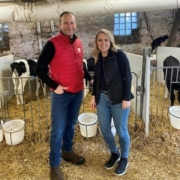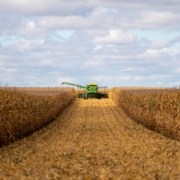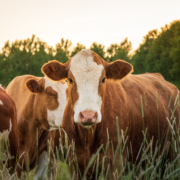From The Fields: The Ups and Downs of 2023
 By Lance Lansing
By Lance Lansing
2023 certainly felt like a rollercoaster ride for the ag economy. After two consecutive years of record or near-record high market prices, the outlook for 2023 was not as rosy. Then we had drought conditions in the corn belt and upper Midwest that caused more production and market uncertainty. Market prices continued to steadily go lower with few exceptions. With increases in land values, rent, interest rates, and questionable yields, 2023 brought up the old proverb that we are “living in interesting times.” All in all, we never felt secure about having decent profits in 2023 like we did in 2022. As ag lenders, we are used to seeing income and profit in cycles with some years leaner than others but, in my opinion, this year had more question marks than usual.
So, let’s look at the farm sector profits forecast put out by USDA in November of 2023.
“Net cash farm income is forecast at $157.9 billion in 2023, a decrease of $42.5 billion (21.2%) relative to 2022 (not adjusted for inflation). This follows an increase of $51.1 billion (34.2%) from 2021 to 2022. When adjusted for inflation, 2023 net cash farm income is forecast to decrease by $49.2 billion (23.8%) from a record high of $207.1 billion in 2022. Despite the decrease, net cash farm income in 2023 would be 15.0% above its 2003–2022 average of $137.3 billion. Net cash farm income encompasses cash receipts from farming as well as cash farm-related income (including Federal Government payments) minus cash expenses. It does not include noncash items (including changes in inventories, economic depreciation, and gross imputed rental income of operator dwellings) reflected in the net farm income measure.” Excerpt taken from Farm Sector Income Forecast published by USDA November 30, 2023.
As you can see from the USDA’s 2023 income forecast, the ag sector is way down from last year but still above the average from 2003–2022. With the reduction in net income, my first thought was that we would see some serious red ink, but income was high enough that our well-run operations will still be operating in the black. Many came into 2023 in a good liquidity position due to the high net profits in 2022 and land value continued to appreciate throughout the year. Another contributing factor to good liquidity was the lack of availability for expansion due to shortages in supplies and labor. Keeping cash on the balance sheet is always a good idea during uncertain times.
Agricultural land values increased by 8.1% from 2022 but even more impressive is that from 2009 to 2023 cropland value increased 107%. Pastureland increased from 2009 by 66%. This cost increase with higher interest rates is creating a high barrier of entry for young farmers and limiting expansions for many operations. In Wisconsin we saw the average value per acre go from $5,700 to $6,200 per acre. That is an 8.8% increase from 2022 to 2023. The more impressive increase though is the average value in 2019 was $4,950 making the last four-year increase over 20%. This kind of increase with the prime rate going from 4.75% in October of 2019 to 8.5% in July of 2023 has created a market that has slowed some operations from investing in cropland for expansion.
Rents have also been cost prohibitive to some operations. Landlords seeing 2022 market prices have been asking for more rent. Higher market prices have sparked more competition and bidding wars between producers for the available tillable soil. The rent market will adjust faster than other inputs, but it is continuing to creep up year on year.
Lastly, we will look at the yields for 2023. Overall, Wisconsin crop production declined in 2023. If you had asked me in June about the harvest, I would have categorially said we will have little to no yield in our area, but 2023 kept surprising us. Corn production is forecast to be down 5%. Yields are expected to average 171 bushels per acre, down 9 bushels from last year. To me, that is incredible for how we started the year. The yield was down due to several factors including the dry weather conditions. Soybean production is forecast to be down 9% from the previous year. The average forecasted yield is 49 bu. per acre. Still an incredible outcome considering how the year started.
The takeaways of 2023 for me include the following:
- Our state’s agriculture economy is still going strong and may have dodged a bullet in 2023
- Stronger yields than expected and some decline in input costs will help our strong credits remain profitable
- Our marginal and weaker credits will struggle in years like 2023 but should have fared better than expected with better yields and carful marketing
I have not touched on the livestock or the dairy markets because they would need their own articles this year. Milk prices from July of 2022 to July of 2023 dropped $8.90. That market saw its own rollercoaster ride. The beef market has seen new highs and continues to remain strong. We have seen our cow/calf operations make very good profits this year and this trend looks to continue for the near future.
From the way this year started, I think we can all breathe a sigh of relief that we continue to work in a great industry that will persevere another year. Happy New Year! I can’t wait to see what 2024 brings.
Lansing is vice president – lending at Apple River State Bank in Darlington. Lansing also currently serves on the WBA Agricultural Bankers Section Board of Directors.








